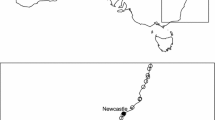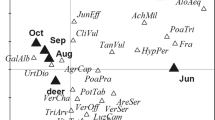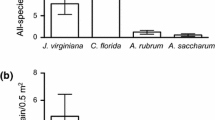Summary
Factors not directly related to either the plants or their avian seed-dispersal agents are ultimately responsible for the sign and magnitude of the average contribution of seed vectors to the fitness of Rosa canina plants in southern Spain. Coexistence with simultaneously fruiting Crataegus monogyna, reproductive depression caused by browsing ungulates, and seed predation by mice, are some of these factors. Disperser behaviour may either enhance, depress, or be neutral to Rosa fitness depending on the relative importance of the reproductive depression caused by browsing ungulates (pre-dispersal) and mice (post-dispersal). The contribution of seed vectors to Rosa fitness is largely independent of their dispersal-related traits and out of the control of the parent plants. Environmental constraints external to the plant-seed disperser interaction seem therefore to impose very restrictive, limits on the maximum degree of adaptedness attainable by dispersal-related plant traits, thus operating against coevolution.
Similar content being viewed by others
References
Denslow JS, Moermond TC (1982) The effect of accessibility on rates of fruit removal from tropical shrubs: an experimental study. Oecologia (Berlin) 54:170–176
Ehrlich PR, Raven PH (1964) Butterflies and plants: a study in coevolution. Evolution 18:586–608
Eldridge MJ (1969) Observations on food eaten by wood mice (Apodemus sylvaticus) and bank voles (Clethrionomys glareolus) in a hedge. J Zool (Lond) 158:208–209
Fernández Galiano E (1960) Mapa de vegetación de la provincia de Jaén (mitad oriental). Inst Est Giennenses, Jaén, Spain
Fleming TH (1981) Fecundity, fruiting pattern, and seed dispersal in Piper amalago (Piperaceae), a bat-dispersed tropical shrub. Oecologia (Berlin) 51:42–46
Font Quer P (1980) Plantas medicinales. Editorial Labor, Barcelona, Spain
Frost PGH (1980) Fruit-frugivore interactions in a South African costal dune forest. In: Nöhring R (ed) Acta XVII Congr Int Orn Deutschen Orn Ges, Berlin, West Germany, pp 1179–1184
Gilbert LE, Raven PH (1975) Coevolution of animals and plants. Texas Univ Press, Austin, Texas, USA
Goodwin TW, Goad LJ (1971) Carotenoids and triterpenoids. In: Hulme AC (ed) The biochemistry of fruits and their products, vol 1. Academic, Press, London, pp 305–368
Harper JL (1977) Population biology of plants. Academic Press, London
Harper JL, White J (1974) The demography of plants. Ann Rev Ecol Syst 5:419–463
Herrera CM (1981a) Are tropical fruits more rewarding to dispersers than temperate ones? am Nat 118:896–907
Herrera CM (1981b) Fruit food of robins wintering in southern Spanish mediterranean scrubland. Bird Study 28:115–122
Herrera CM (1982a) Defense of ripe fruits from pests: its significance in relation to plant-disperser interactions. Am Nat 120:218–241
Herrera CM (1982b) Seasonal variation, in the quality of fruits and diffuse coevolution between plants and avian dispersers. Ecology 63:773–785
Herrera CM (1984a) Selective pressures on fruit seediness: differential predation of fly larvae on the fruits of Berberis hispanica. Oikos 42:166–170
Herrera CM (1984b) Avian, interference of insect frugivory: an exploration into the plant-bird-fruit pest evolutionary triad. Oikos 42:203–210
Herrera CM (1984c) Determinants of plant-animal coevolution: the case of mutualistic dispersal of seeds by vertebrates. Oikos (in press)
Herrera CM (1984d) Escala espacial y evolución de los mutualismos planta-dispersante: estudios en la Sierra de Cazorla. Actas Sem Res Biosfera La Rábida, Huelva, Spain (in press)
Herrera CM (1984e) A study of avian frugivores, bird-dispersed plants, and their interaction in, Mediterranean scrublands. Ecol Monogr 54:1–23
Herrera CM, Jordano P (1981) Prunus mahaleb and birds: the high-efficiency seed dispersal system of a temperate fruiting tree. Ecol Monogr 51:201–218
Howe HF, Smallwood J (1982) Ecology of seed dispersal. Ann Rev Ecol Syst 13:201–228
Howe, HF, Vande Kerckhove GA (1979) Fecundity, and seed dispersal of a tropical tree. Ecology 60:180–189
Janzen DH (1977) Why fruits rot, seeds mold, and meat, spoils. Am Nat 111:691–713
Janzen DH (1982) Removal of seeds from horse dung by tropical rodents: influence of habitat and amount of dung. Ecology 63:1887–1900
Janzen DH (1983) Dispersal of seeds by vertebrate guts. In: Futuyma DJ, Slatkin M (eds) Coevolution. Sinauer, Sunderland, Massachusetts, pp 232–262
Jordano P (1982) Migrant birds are the main seed dispersers of blackberries in southern Spain. Oikos 38:183–193
Manasse RS, Howe HF (1983) Competition for dispersal agents among tropical trees: influences of neighbors. Oecologia (Berlin) 59:185–190
Manzur MI, Courtney SP (in press) Coevolution of Crataegus monogyna, frugivores and seed predators. Influence of insect damage on bird foraging and seed dispersal. Oikos
Mapson LW (1971) Vitamins in fruits. In: Hulme AC (ed) The biochemistry of fruits and their products, vol 1. Academic Press, London, pp 369–384
McKey D (1975) The ecology of coevolved seed dispersal systems. In: Gilbert LE, Raven PH (eds) Coevolution, of animals and plants. Texas Univ Press, Austin, Texas, pp 159–191
Moermond TC, Denslow JS (1983) Fruit choice in neotropical birds: effects of fruit type and accessibility on selectivity. J Anim Ecol 52:407–420
Moore LA, Willson MF (1982) The effect of microhabitat, spatial distribution, and display size on dispersal of Lindera benzoin by avian frugivores. Can J Bot 60:557–560
Otero C, Castien E, Senosiain R, Portillo F (1978) Fauna de Cazorla, Vertebrados. Instituto Conserv Nat, Madrid, Spain
Polunin O, Smythies BE (1973) Flowers of south-west Europe. Oxford Univ Press, London
Snow DW (1971) Evolutionary aspects of fruit-eating by birds. Ibis 113:194–202
Author information
Authors and Affiliations
Rights and permissions
About this article
Cite this article
Herrera, C.M. Seed dispersal and fitness determinants in wild rose: Combined effects of hawthorn, birds, mice, and browsing ungulates. Oecologia 63, 386–393 (1984). https://doi.org/10.1007/BF00390670
Received:
Issue Date:
DOI: https://doi.org/10.1007/BF00390670




